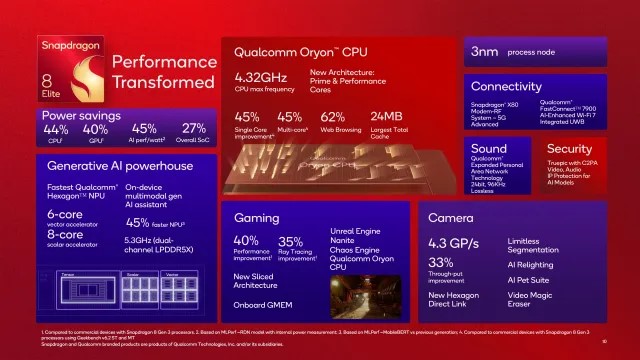At its recent flagship launch event, Snapdragon Summit, Qualcomm brought the Oryon CPU to its smartphone platform. Building on the first-generation Oryon CPU that was first introduced last year with the company’s AI PC chip, the X Elite, the company announced its latest generation mobile SoC for smartphones, the Snapdragon 8 Elite.
The new SoC uses the second-generation Oryon CPUs clocked at a maximum frequency of 4.32 GHz combined with 24MB of total CPU cache and 5.3GHz LPDDR5x memory. Compared with the previous generation, the new CPU delivers a 45% increase in CPU performance and a 44% improvement in power consumption, according to Qualcomm.
In a departure from its previous naming conventions, which would have made this the Snapdragon 8 Gen 4, Qualcomm carried over the “Elite” branding from X Elite. As became apparent with the other SoCs announced at the event, Qualcomm is using the “Elite” branding to denote SoCs powered by its custom Oryon CPUs.
Two cores in one
Performance and power consumption are conflicting metrics that are often traded off with each other. Delivering improvements on both fronts is not an easy task. For the Oryon CPU, this was accomplished mainly with an SoC microarchitecture consisting of two “prime” cores and six “performance” cores.
Some might ask, “Is this just a renaming of the big-little microarchitecture where Qualcomm is just calling the performance cores, ‘prime’ cores and the efficiency cores, ‘performance’ cores?” While on the surface, this might seem like the case. Upon closer inspection, there is one key difference that makes this not simply a marketing exercise but a true engineering accomplishment.
In this microarchitecture, the two prime cores do provide the maximum performance at a higher power profile. In that sense, it is taking on the role of the “big” core in the big-little microarchitecture. The key differentiation comes in what the Oryon CPUs performance cores are capable of. They are basically both a traditional performance core and an efficiency core enabled by the dynamic range of the Oryon CPUs performance core’s processing versus power curves.
A core is typically categorized as “performance” or “efficiency” based on the types of workloads it can support with the processing power it can bring to bear and the power it requires to do so. Based on its internal design (microarchitecture), these cores have a defined dynamic range in which processing power can be scaled up or down by controlling its power consumption. Efficiency cores are typically lower power and lower complexity cores and, as such, are limited with how much it can scale up in terms of processing capability.
On the other hand, typical performance cores are designed for higher processing capabilities but at the cost of a higher power consumption profile. Traditionally, while they are more than powerful enough to process workloads that efficiency cores can support, it does not make sense to use them in that manner given the cost in higher power consumption when dealing with lighter compute tasks.
What makes the Oryon CPU different is that its performance cores are both traditional performance cores and efficiency cores in one. The range in which it can scale, in terms of processing and power, covers the lower ranges like an efficiency core. However, the microarchitecture design allows it to scale up its power consumption and thus its processing performance to address typical performance core workloads.
The second-gen Oryon CPU has six of these performance cores. When paired with two of what Qualcomm is calling an even more capable “Prime” core clocked at up to 4.32GHz, the company is confident that its latest SoC has more than enough horsepower, while ensuring increased battery life for the next evolution of AI smartphones. This was further demonstrated at the event when Qualcomm benchmarked the smartphone SoC against AI PC SoCs from their competition—and based on their numbers, Qualcomm won.
The new CPU is just one of the design elements that Qualcomm is hoping will set the stage for agentic AI in smartphones.
The evolution to agentic AI
Currently, generative AI applications are primarily transactional and responsive in nature. This is rapidly evolving into what many are calling “agentic AI,” which aims to introduce more autonomy, sophisticated reasoning and multi-step problem-solving using AI agents. In this paradigm, agentic AI utilizes inputs from as many on-device sensors as possible, coupled with other contextual information and learned behaviors to not only respond to human queries but to provide recommendations and, eventually, autonomous decision-making.
Along with the new Oryon CPU, Qualcomm has introduced features in the Snapdragon 8 Elite that build towards agentic AI capability. Two such improvements are enhanced multi-modal input capabilities and direct NPU access to the image sensor feed.
Multi-modal inputs to the GenAI inference models are critical in allowing agentic AI models to receive as much context at any given snapshot in time as possible, just like humans take input from multiple senses at the same time to process the world around them. This capability is not simply just being able to ingest audio, image, sensor or video inputs, but it is the cognitive ability to stitch all of the inputs together to provide a complete context upon which the AI model can act.
Enabling the NPU to have direct access to the image sensor feed dramatically enhances the ability for the camera to be used as not just something that captures pixels but as a real-time sensor that the AI models can efficiently use, providing contextual digital information on the analog world in which the device is operating. This goes beyond object detection and classification. It also extends to time-of-flight sensing, depth perception and other information similar to how humans utilize vision. Depending on the type of image sensor being used, this capability can even be extended past what humans can perceive by providing information outside of the visible spectrum into the infrared and ultraviolet ranges.
Are we there yet?
Agentic AI is not quite here yet and will require further enhancements in GenAI autonomy, sophisticated reasoning and multi-step problem-solving. These enhancements will need further development on multiple fronts, from processing capabilities and memory performance to improved multi-modal sensor inputs and advancements in fine-tuning AI models.
However, with the capabilities that Qualcomm has introduced in the Snapdragon 8 Elite, the first essential steps down that evolutionary path have been taken, and it will only be a matter of time before our smartphones truly become personal assistants that not only provide us with information but can act as agents on our behalf.


